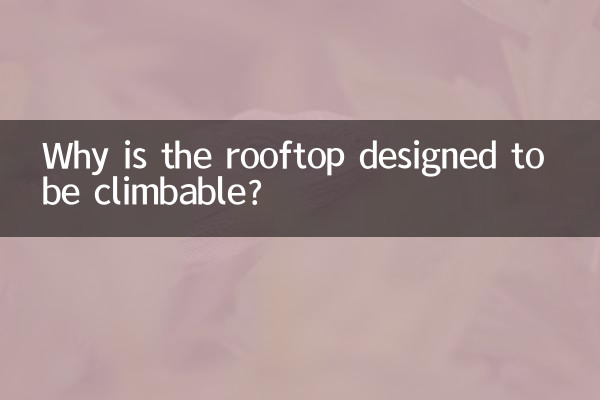Why is the rooftop designed to be climbable?
In recent years, with the acceleration of urbanization, the rooftop design of high-rise buildings has gradually become the focus of public attention. In particular, the design concept of "the rooftop can be climbed" has triggered widespread discussion. This article will start from the hot topics and hot content on the Internet in the past 10 days to explore the rationality of rooftop design and the social significance behind it.
1. Hot topics and content in the past 10 days

According to the data analysis of the entire network, topics related to "rooftop design" in the past 10 days have mainly focused on the following aspects:
| topic | heat index | Main discussion points |
|---|---|---|
| Rooftop safety | 85 | Are protective measures in place and whether there are any safety hazards? |
| Rooftop functionality | 78 | Should the rooftop be opened as a public space, such as leisure, viewing, etc. |
| Building design codes | 72 | Requirements and restrictions on rooftop design under current regulations |
| Impact of social events | 65 | The impact of recent rooftop-related incidents on public psychology |
2. The rationality of the rooftop design being climbable
1.functional requirements: As the top space of a building, the rooftop is often designed to meet ventilation, equipment placement and other needs. However, with the improvement of urban space utilization, rooftops have gradually been given more functions, such as leisure, viewing, and even small event venues. Therefore, the "climbable" design is partly to meet these functional requirements.
2.emergency escape route: In high-rise buildings, rooftops are sometimes designed as part of emergency escape routes. When a fire or other emergency occurs, the rooftop can be used as a temporary shelter to await rescue. Therefore, the accessibility of the rooftop is designed for safety reasons.
3.psychological and aesthetic value: The rooftop’s broad vision and unique perspective can provide people with psychological relaxation and aesthetic enjoyment. Through a "climbable" design, the designer gives the public the opportunity to have close contact with the city's skyline and enhances the interaction between the building and people.
3. Social significance of rooftop design
1.extension of public space: In the context of increasingly tight urban land resources, rooftops, as potential public spaces, can relieve the pressure on ground space. Through reasonable design, the rooftop can become a new place for citizens to relax and socialize.
2.Improvement of city image: Unique rooftop design can become a city landmark, attracting the attention of tourists and investors. For example, the "sky garden" projects in some cities not only enhance the image of the city, but also drive the development of the surrounding economy.
3.The balance between security and management: Although the rooftop design can be climbed, how to balance openness and safety is an issue that needs to be solved urgently. By strengthening management measures (such as setting up monitoring, limiting opening hours, etc.), the utilization value of the rooftop can be maximized while ensuring safety.
4. Summary
The concept of a climbable rooftop is not only an expansion of building functions, but also an innovation in the use of urban space. However, this design needs to find a balance between safety, functionality and social needs. In the future, as technology advances and public awareness increases, rooftop design may usher in more possibilities.
Through the above analysis, we can see that rooftop design is not only an architectural issue, but also a complex issue intertwined with social, psychological, safety and other factors. Only by comprehensively considering these factors can we design a rooftop space that is both beautiful and practical.

check the details

check the details